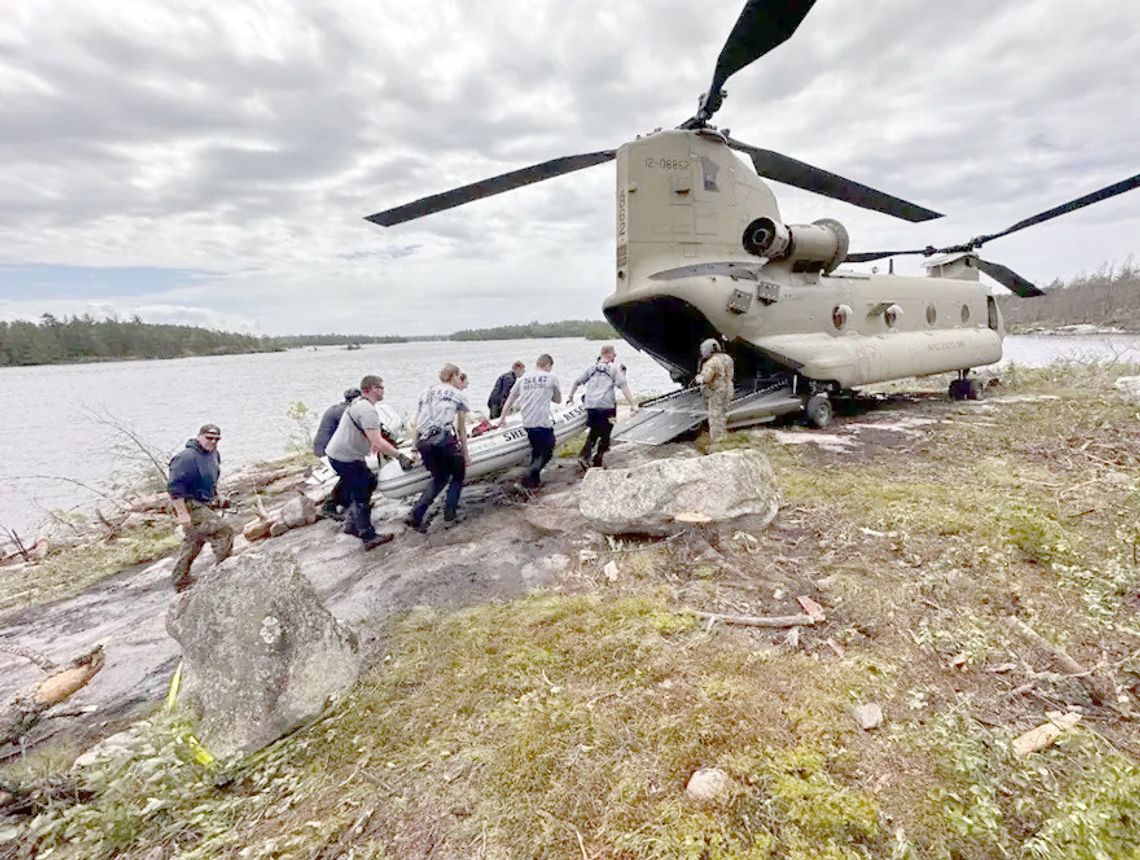May 18 began as a picture perfect day for Erik Grams — until it turned to tragedy.
He was with his brother and friends at Curtain Falls, deep in the Boundary Waters Canoe Area Wilderness. The place held special meaning to him. He’d been paddling there for years. It’s where he proposed to his wife.
It was about 4 o‘clock. The sun was shining and the fishing superb. He and his brother Reis were just about to head back to camp, when they saw that their friends Jesse Haugen and Kyle Sellers were way too close to the top of the falls. Then they tipped.
“Kyle was hanging on to the canoe, and Kyle went over the falls first with the canoe. And at that moment it was complete disbelief and horror.”
But Jesse was still there, standing
in chest deep water, bracing himself against the powerful current. They paddled toward him. Jesse lunged for their canoe, and all three went over the falls.
“My next recollection is I’m underneath the water, about 10 feet deep,” Grams recalled. “I swam to the light as hard as I could. And I was able to surface for a brief second.”
He gulped a quick breath of air. “And I was immediately pulled underneath the water again,” he said.
Grams struggled to the surface, then was sucked back under. He surfaced again, was pulled back down, until finally, he made it to shore. His shoes had been torn off by the water. He walked barefoot to the bottom of the falls, where Kyle was stranded on an island.
Then, another canoeist appeared. He paddled Erik over to Kyle, and used a satellite communicator to call for help.
About eight hours later, just after midnight, a Minnesota Department of Natural Resources helicopter evacuated Kyle. Then it returned for Erik.
And shortly after he was flown out, the first members of the St. Louis County Rescue Squad flew in to search for the two canoeists still missing.
They’d stay there for the next 18 days.
“Curtain Falls was the biggest call in rescue squad history,” said squad captain Rick Slatten.
Of the 95 members of the St. Louis County Rescue Squad, 61 took part in the Curtain Falls mission. Combined they worked almost 6,000 hours. For free. They’re all volunteers.
“There are cops, there are nurses. There is a professor of geology, there’s heavy equipment operators, we have a surgeon. It’s all walks of life,” Slatten said.
They range in age from 18 to 70. There are 17 people on the waiting list eager to join. Twenty-eight percent are under the age of 24.
“I hear this nonsense that Gen Z doesn’t want to volunteer and I say ‘hogwash,’” Slatten said. “We give people meaning. A chance to be part of something much bigger than themselves.”
The St. Louis County Rescue Squad formed in 1958. Slatten’s father was one of the charter members. His earliest memories are of his dad getting dressed for searches, and staying up past his bedtime to hear his stories when he returned. “ I h ave t he search gene in my DNA,” Slatten said. He walked his first search with his dad in 1976, when he was 13 years old. He’s 61 now, retired from his day job. He estimates he logs 60 hours a week leading the squad, which responds to over 400 calls a year. “We search for everybody from missing hunters to missing paddlers, to Alzheimer’s patients to meth addicts, to people who do monumentally stupid things,” Slatten said.
“And none of that matters. It doesn’t matter why they’re missing. It’s a family [that] has missing loved ones. And it’s our job to go out and find them. And that’s my meaning. That’s why I’m here.”
Tight-knit family The work can be intense, emotional and physically exhausting.
Alex Messenger, who’s volunteered on the rescue squad for the past decade, recalls responding to a call from someone with a broken leg on Lake Agnes in the Boundary Waters. He and his partner arrived at the entry point at midnight. A long paddle with several portages lay ahead.
“It’s definitely a mental game to be going out into the wilderness in the pitch black in the middle of the night,” Messenger said. “And that’s part of what our training is for.” Squad members receive a host of training, from medical, to navigation, to ropes and swiftwater rescues, to operating high-tech equipment like remote underwater vehicles, to driving different vehicles and piloting boats. That night they made it to the canoeist’s campsite and stabilized her injuries. A beaver plane evacuated her the next morning. “And then we paddled back home and went back to our jobs,” Messenger said with a laugh. “It was a big adventure.” Those experiences forge tight bonds among squad members.
“We’ve all been through some stuff together,” said 27-year old ER nurse Alaina Gacek. “And I’ll tell anybody that these guys are my family up here. I’ll call any of them for anything.”
Gacek was one of only a handful of women when she joined six years ago. Now more than a quarter of the rescue squad is female.
“We have such a culture here. It was like we were no different,” said Gacek, who joined with outdoors experience, she said, but little else. “No health care experience, no rescue experience. Nothing. They’ve taught me everything I know.”
While the rescue squad’s operations in the Boundary Waters, such as the Curtain Falls mission, are often their most high-profile, they don’t make up a huge percentage of their work.
Over the past eight years, the number of annual operations in the wilderness and surrounding National Forest has ranged from 16 to 30. In 2020, an outlier year during the COVID pandemic, the rescue squad responded to 39 incidents, totaling nearly 1,200 volunteer hours.
Slatten and others say they are seeing more inexperienced people in the wilderness, “tenderfeet,” he calls them, especially since COVID, when people sought refuge in the outdoors.
That can sometimes result in frustrating calls.
Slatten recalled a solo camper in the Boundary Waters who took a day trip through a chain of lakes outside Ely, deeper into the wilderness, carrying only a water bottle. He dropped his paddle, and it washed away.
“So now he’s stuck there with no gear, and a half empty water bottle. This guy calls 911 to say ‘bring me a paddle.’ And we weren’t too happy with him. But we went. We took care of business.”
Because of incidents like that, in some areas people are charged if they need to be rescued.
Slatten said he’s dead-set against that idea.
“What it will cause to happen is that people will wait until it’s irrevocably life threatening before they call 911,” Slatten said. “Or they will engage in some ill-advised rescue attempt on their own and make matters worse.”
Instead, some St. Louis County officials are pushing for federal reimbursement to help pay for rescues on federal land in the Boundary Waters.
While the squad’s 90-plus members donate their time, it still costs about $420,000 a year to run the unit, Slatten said. The rescue squad raises about $100,000 a year through an annual mailing sent to county residents. Much of the rest is covered by the county.
St. Louis County Commissioner Paul McDonald of Ely said the county gets reimbursed by the federal government when it helps fight wildfires on federal land. He said they should also get repaid for search and rescue efforts.
“We’re just trying to get things moving and get a discussion going that in the long term will help the taxpayers of St. Louis County,” McDonald said.
Data and a dog
At Curtain Falls in the Boundary Waters, rescue squad crews rotated in and out, searching for the missing bodies for 16 days.
They battled thunderstorms, fluctuating water levels, terrible bugs, fatigue and the stress of camping and sleeping next to the falls, where they worked all day, the constant roar of the water unceasing in the background.
U.S. Forest Service beaver planes flew in crews and supplies. A National Guard Chinook helicopter ferried in a jet boat.
Crews searched in inflatable Zodiacs and canoes. They used sonar scanners, drones and remote operated mini subs. They analyzed the water, and used their knowledge of how bodies behave underwater to help determine where to focus their searches.
“Searches are solved by data,” explained Slatten. “They’re not solved by luck.”
Search and rescue missions do not consist of hundreds of people lined up shoulder to shoulder, randomly searching the ground, as they’re often portrayed in popular culture, Slatten said. “It’s way more scientific than that.”
At Curtain Falls, a young, yellow Labrador retriever named Rooster proved instrumental in finding the missing canoeists.
Search and rescue canines can pick up the scent of human remains even in the water, said Dave Drozdowski, a dog handler for the rescue squad who works as a lieutenant with the Duluth Police Department.
“When there’s a body under the water, there’s oils that come off of it and it comes up at the surface. And they detect that.”
But at Curtain Falls it proved difficult to pinpoint the exact origin of the scent, because of the power of the falls, which created its own wind currents and clouds of mist.
“So everything’s getting mixed up. You can almost think of the scent as smoke coming out of a fire,” Drozdowski said.
Eventually Rooster helped lead the team to the body of Jesse Haugen downstream of the falls, and then to the body Reis Grams, who was still trapped in a huge, churning pool below the falls.
For Rick Slatten, who led the search crews for 10 days at the falls, the discoveries brought a tremendous sense of satisfaction, and relief.
“Thanks to God for giving us a chance to shine and for helping us to be successful in this incredibly difficult environment,” he said.
“But also that hyper-vigilance, of looking out for each other, looking for two missing loved ones, concern for everybody else’s safety.”
Most missions have happy endings. They end in rescues, not recoveries. Those that don’t often have a common thread.
“In the history of the rescue squad there have been 507 water fatalities,” Slatten said. “Only 14 were wearing life jackets.”
Erik Grams knew this mission to find his brother and friend was in all likelihood not going to end in a rescue. Still he says finding the bodies brought closure to the families.
“We were hoping for the miracle,” Grams said. “But it was still a miracle that they were able to recover both Jesse and Reis and get our families the closures that we needed, because sometimes these can last for a very long time. It would have been excruciating to have this thing continue to drag on without recovering our boys.”
Now Grams says they can try to move on with their lives. That includes going back to the Boundary Waters. They plan to return to Curtain Falls next year on the anniversary of his brother’s death.
“This isn’t going to stop the love and passion for nature and the outdoors,” Grams said. “That’s the way that Reis and Jesse would want it.”
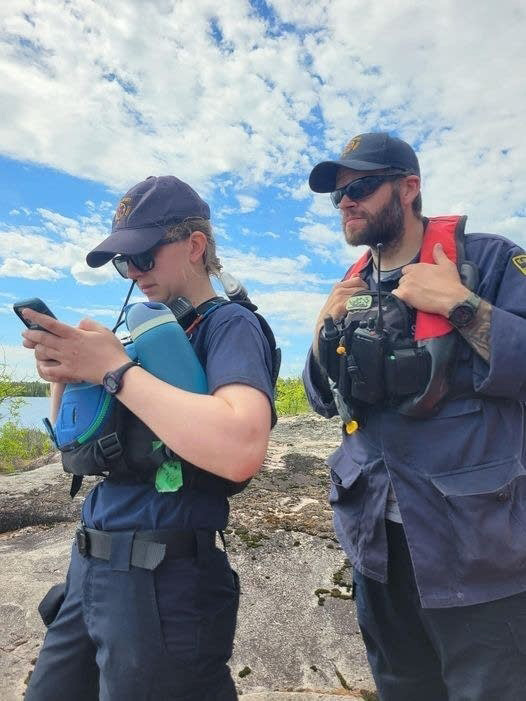
Alaina Gacek uploads GPS coordinates during a boat search near Curtain Falls, while pilot Pete Brautigam looks on. Photo courtesy of the St. Louis County Rescue Squad
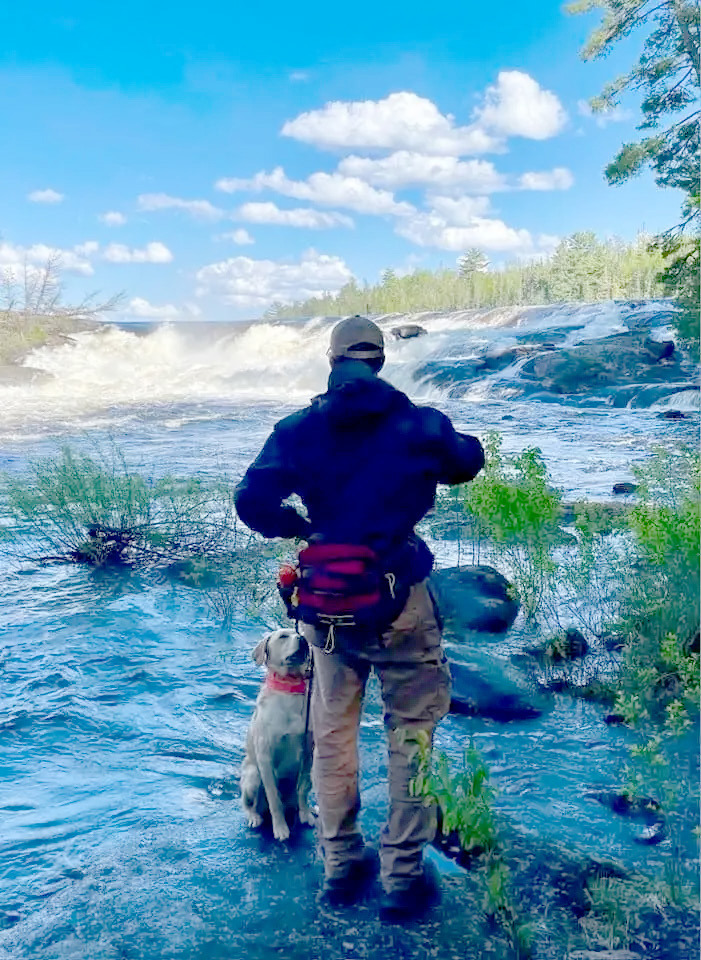
Dave Drozdowski and Rooster, a search and rescue canine trained to detect human remains, inspect a giant eddy at the bottom of Curtain Falls. “This was a beautiful, yet intimidating and dangerous environment. The picture doesn’t capture the roar of the water, the wind currents generated by the falls, and the constant mist in the air,” Drozdowski said. Photo courtesy of the St. Louis County Rescue Squad
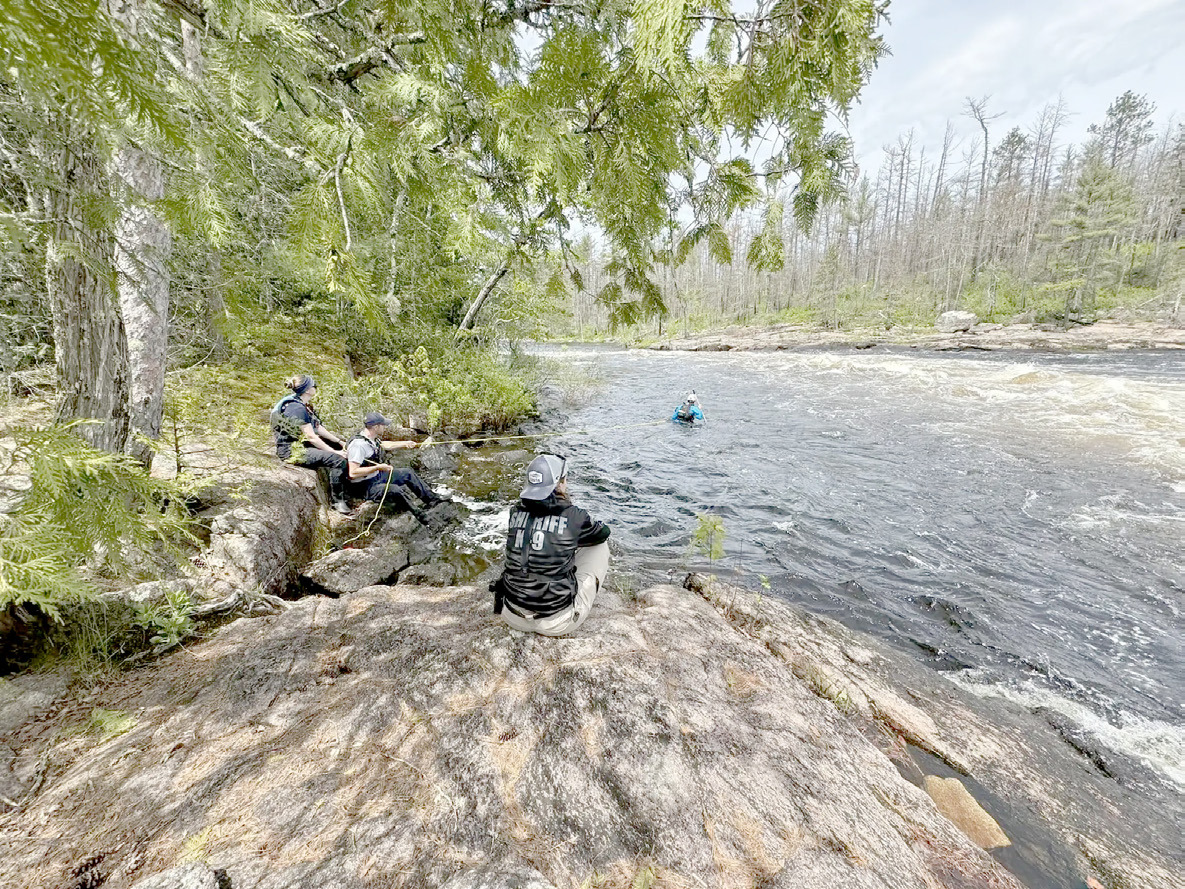
Members of the St. Louis County Rescue Squad perform a “swiftwater sortie” below Curtain Falls. Photo courtesy of the St. Louis County Rescue Squad
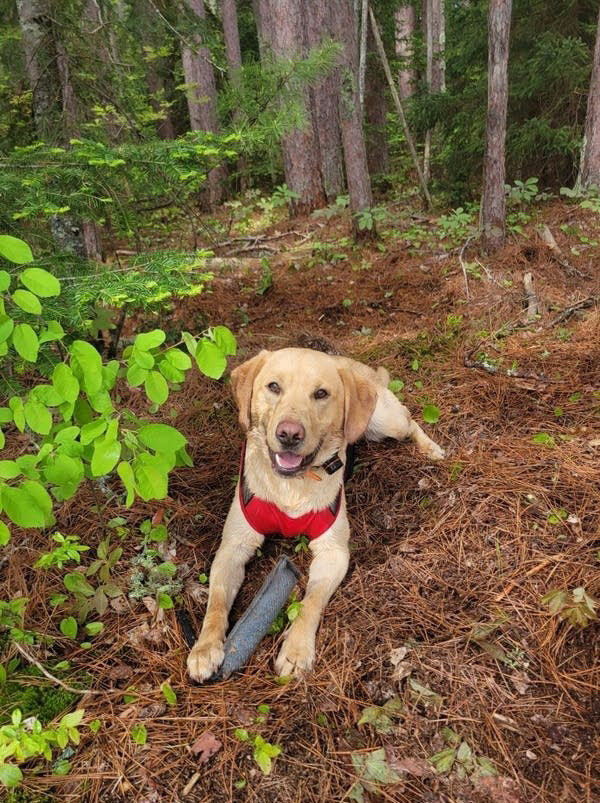
Rooster, a 1-year old yellow lab, played an instrumental role in finding two missing canoeists at Curtain Falls. Photo courtesy of the St. Louis County Rescue Squad

